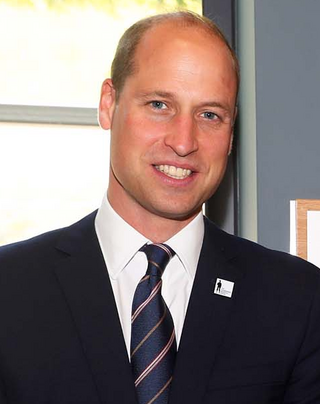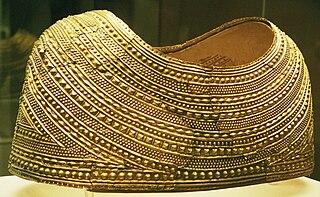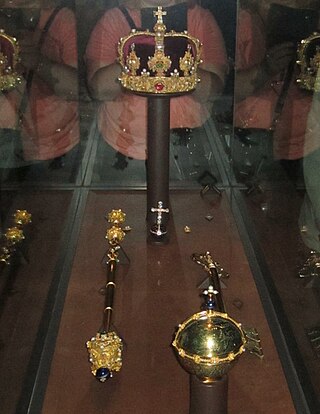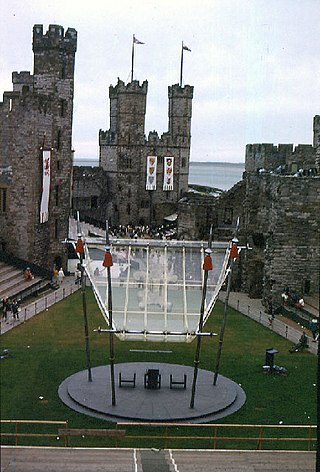
Prince of Wales is a title traditionally given to the male heir apparent to the English and, later, British thrones. The title originated with the Welsh rulers of Gwynedd who, from the late 12th century, used it to assert their supremacy over the other Welsh rulers. However, to mark the finalisation of his conquest of Wales, in 1301, Edward I of England, invested his son Edward of Caernarfon with the title, thereby beginning the tradition of giving the title to the heir apparent when he was the monarch's son or grandson. The title was later claimed by the leader of a Welsh rebellion, Owain Glyndŵr, from 1400 until 1415.

Crown jewels are the objects of metalwork and jewellery in the regalia of a current or former monarchy. They are often used for the coronation of a monarch and a few other ceremonial occasions. A monarch may often be shown wearing them in portraits, as they symbolize the power and continuity of the monarchy. Additions to them may be made, but since medieval times the existing items are typically passed down unchanged as they symbolize the continuity of the monarchy.

Duke of Cornwall is a title in the Peerage of England, traditionally held by the eldest son of the reigning British monarch, previously the English monarch. The duchy of Cornwall was the first duchy created in England and was established by a royal charter in 1337. Prince William became Duke of Cornwall following the accession of his father, King Charles III, to the throne in 2022, and his wife, Catherine, became Duchess of Cornwall.

The Crown Jewels of the United Kingdom, originally the Crown Jewels of England, are a collection of royal ceremonial objects kept in the Jewel House at the Tower of London, which include the coronation regalia and vestments worn by British monarchs.

The Honours of Scotland, informally known as the Scottish Crown Jewels, are the regalia that were worn by Scottish monarchs at their coronation. Kept in the Crown Room in Edinburgh Castle, they date from the 15th and 16th centuries, and are the oldest surviving set of crown jewels in the British Isles.

In British heraldry, a coronet is the term used to denote any crown whose bearer is less than sovereign or royal in rank, irrespective of the crown's appearance. In other languages, this distinction is not made, and usually the same word for crown is used irrespective of rank In this use, the English coronet is a purely technical term for all heraldic images of crowns not used by a sovereign, and implies nothing about the actual shape of the crown depicted.

Prince of the United Kingdom of Great Britain and Northern Ireland is a royal title normally granted to sons and grandsons of reigning and past British monarchs, together with consorts of female monarchs. The title is granted by the reigning monarch, who is the fount of all honours, through the issuing of letters patent as an expression of the royal will.

Welsh gold is gold found in natural geological deposits in two distinct areas of Wales and highly prized because of its origin and scarcity.

The regalia of Norway are items that symbolise the Norwegian monarch's power and majesty. Little is known of the old Norwegian regalia which have since been lost. The majority of the modern regalia date from 1818 and were made for the coronation of Jean Bernadotte as King Carl III Johan.

The Coronet of Charles, Prince of Wales is a small crown that is part of the Honours of Wales. The gold coronet, with diamonds set in platinum, was made for and used by King Charles III at his investiture as Prince of Wales in 1969. Designed by the artist Louis Osman, the coronet was a gift from the Worshipful Company of Goldsmiths to the Prince's mother, Queen Elizabeth II. It has been described as modern but its form is traditional. The coronet is on permanent display in the Jewel House at the Tower of London.

Llywelyn's coronet is a lost treasure of Welsh history. It is recorded that Llywelyn ap Gruffudd, Prince of Wales and Lord of Aberffraw had deposited this crown and other items with the monks at Cymer Abbey for safekeeping at the start of his final campaign in 1282. He was killed later that year. It was seized alongside other holy artefacts in 1284 from the ruins of the defeated Kingdom of Gwynedd. Thereafter it was taken to London and presented at the shrine of Edward the Confessor in Westminster Abbey by King Edward I of England as a token of the complete annihilation of the independent Welsh state.

Sweden's regalia are kept deep in the vaults of the Royal Treasury, underneath the Royal Palace in Stockholm, in a museum that is open to the public. The crowns and coronets have not been worn by Swedish royalty since 1907, but they are still displayed at weddings, christenings and funerals.
In the British peerage, a royal duke is a member of the British royal family, entitled to the titular dignity of prince and the style of His Royal Highness, who holds a dukedom. Dukedoms are the highest titles in the British roll of peerage, and the holders of these particular dukedoms are princes of the blood royal. The holders of the dukedoms are royal, not the titles themselves. They are titles created and bestowed on legitimate sons and male-line grandsons of the British monarch, usually upon reaching their majority or marriage. The titles can be inherited but cease to be called "royal" once they pass beyond the grandsons of a monarch. As with any peerage, once the title becomes extinct, it may subsequently be recreated by the reigning monarch at any time.

The Prince of Wales is sometimes presented and invested with the insignia of his rank and dignity in the manner of a coronation. The title is usually given to the heir apparent of the English or British throne. An investiture is ceremonial, as the title is formally conferred via letters patent issued by the monarch.

Coronations were previously held in the monarchies of Europe. The United Kingdom is the only monarchy in Europe that still practises coronation. Current European monarchies have either replaced coronations with simpler ceremonies to mark an accession or have never practised coronations. Most monarchies today only require a simple oath to be taken in the presence of the country's legislature.

The coat of arms of the Prince of Wales is the official personal heraldic insignia of the Princes of Wales, a title traditionally granted to the heir apparent of the reigning monarch of the United Kingdom of Great Britain and Northern Ireland, formerly the Kingdom of Great Britain and before that the Kingdom of England.

The investiture of Charles, Prince of Wales took place in Caernarfon Castle, north Wales, on 1 July 1969. The ceremony formally presented the title of Prince of Wales to the 20-year-old Charles, eldest son of Queen Elizabeth II. He was the 21st heir to the English or British throne to hold the title. The investiture was a revival of a ceremony which had first been used for the previous prince of Wales, Edward, in 1911. The 1969 event was watched by 500 million people worldwide on television, but it received opposition in particular from Welsh nationalist organisations.

The public investiture of Edward, Prince of Wales took place at Caernarfon Castle on Thursday 13 July 1911. This was the first investiture of the Prince of Wales to take place in Wales for centuries: since the 18th century, the Prince of Wales had been invested with his insignia of office privately, outside Wales.
















